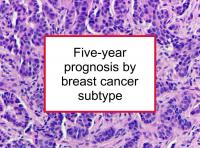Breast cancer prognosis is influenced by a variety of factors, including hormone receptor and HER2 status. A new study of over a thousand women examined the influence of estrogen receptor (ER), progesterone receptor (PR) and HER2 (HER2) status on tumor characteristics at diagnosis, as well as calculating five-year outcomes.
Many studies do not take mixed hormone receptor status (ER+/PR- or ER-/PR+) into account, or combine such tumors with ER+/PR+ tumors for analysis. This means that data concerning mixed receptor types such as provided by this study is hard to come by. The study found that tumor size and lymph node status is associated with breast cancer subtype. In addition, the authors report relapse rates by breast cancer subtype.
Breast cancer prognosis varies according to multiple factors
Breast cancer prognosis varies by a large variety of factors, among them number of positive lymph nodes, tumor size, tumor stage and grade, breast cancer subtype, nature and timing of breast cancer treatment received, age at diagnosis, breast density, family history of breast cancer, ethnicity, body weight, diabetes status, and diet. Studies that produce patient outcome statistics normally focus on just a few of these factors at a time. However, studies linking the various breast cancer subtypes with survival data do provide valuable information concerning the relative aggressiveness of the subtypes, which can help inform decisions about treatment.
Study took mixed hormone receptor disease into account
The study referenced at the beginning of this news article was designed to investigate survival outcomes by breast cancer subtype. The study included 1,167 breast cancer patients who were treated at the hospital of the University of Barcelona, Spain since 1998. Study participants were followed through March 2010. Five-year rates of breast cancer-free survival, breast cancer-specific death, and death from any cause were calculated. Overall survival rates were comparable to U.S. rates.
Tumors were grouped according to ER, PR and HER2 status. Unlike most studies, which tend to exclude mixed hormone receptor (ER+/PR- or ER-/PR+) tumors or combine them with ER+/PR+ disease, the analysis specifically analyzed mixed receptor disease. Seventy-two percent of the tumors were either ER+/PR+/HER2- or ER+/PR-/HER2-, 10% were either ER+/PR+/HER2+ or ER+/PR-/HER2+, 13% were triple negative (ER-/PR-/HER2-), and 5% were ER-/PR-/HER2+.
Tumor size and lymph node status linked to breast cancer subtype
Small, low-grade tumors with low axillary burden (no or minimal axillary lymph node metastases) were most likely in women with ER+/HER2- (ER+/PR+/HER2- or ER+/PR-/HER2-) disease. On the other hand, larger, high-grade tumors with significant axillary burden were more likely to be found in women with ER-/PR-/HER2+ or triple negative tumors.
Relapse rates are higher for some breast cancer subtypes
Five-year breast cancer-specific survival was found to be 94.2% for women with ER+/PR+/HER2- tumors, 83.3% for ER+/PR-/HER2-, 84.8% for ER-/PR-/HER2+, and 78.6% for triple negative disease. The rate of distant metastasis varied from 7% to 22% across subtypes, increasing in order from ER+/PR+/HER2-, ER+/PR+/HER2+, ER+/PR-/HER2-, ER+/PR-/HER2+, ER-/PR-/HER2+ to triple negative. The majority of HER2+ tumors are also ER-/PR-. HER2+ and triple negative tumors have a well deserved reputation for aggressiveness, which the study's data on survival and metastases bears out. Hormone receptor positive (ER+/PR+) tumors are the least aggressive (although they are more prone to late recurrence - the majority of the breast cancer relapses that occur after the first seven years are ER+/PR+ disease).
As mentioned earlier, some studies designate ER+/PR- and ER-/PR+, along with ER+/PR+, as "hormone receptor positive" disease. However, as the current study results show, mixed hormone receptor tumors have a prognosis in between ER+/PR+ and ER-/PR- disease. It is also clear that the lack of PR receptor is associated with breast cancer aggressiveness; the subtypes with the four highest rates of recurrence are all PR-. PR receptor status is not given much attention currently and its role in breast cancer progression is not well understood. The study results suggest that treatments specifically targeted to PR- disease might have the potential improve outcomes.
Please see our articles on the prognosis of ER+/PR+, mixed hormone receptor, HER2+, and triple negative disease for more information on outcomes by breast cancer subtype.
